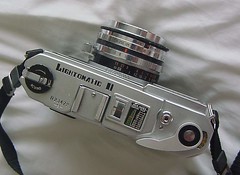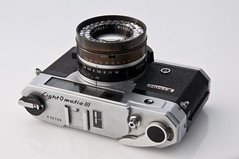Beauty Lightomatic
Contents
Overview
The Beauty Lightomatics are a series of 35mm rangefinder cameras made by the Beauty Camera Company between 1959 and 1963.
Each model shares some common features.
- Viewfinder: Integrated coincidence rangefinder/viewfinder with self-correcting bright line.
- Focus: Coupled rangefinder with manual ring on lens barrel.
- Meter: Selenium meter electro-mechanically coupled to lens barrel aperture, shutter speed settings, and film speed index.
- Exposure: Centre-the-needle system with pointer window on the top plate of the camera, visible in viewfinder from Lightomatic II onwards.
- Lens: 45mm f1.9 (6 elements in four groups double gauss type) stopping down to f16.
- Close Focus: 0.8m / 2'7".
- Shutter:. Five blade Copal-SV shutter with speeds: B, 1, 2, 4, 8, 15, 30, 60, 125, 250 & 500 sec,. plus B. Shutter speeds and aperture settings can be interlocked. The shutter release locks when the advance lever is flush with the camera body.
- Cable Release: Standard socket in shutter release button (Lightomatic II onwards).
- Filter Size: 46mm (Lightomatic & Lightomatic II) 55mm (Lightomatic III & SP) screw in.
- Flash: Cold shoe and PC terminal. M and X sync.
- Film Advance Single stroke lever.
- Frame Counter: Counts up. Resets automatically when camera back is opened.
- Rewind: Collapsible crank, and rewind selector switch.
The Beauty Lightomatic or LM

|
| Lightomatic top view image by Donnatella G (Image rights) |
- The Lightomatic was introduced in 1959.
- The Lightomatic was sold as the LM is some markets.
- The lens is either a Beauty-S or Canter-S.
- The Selenium meter cell window is located on the front of the camera body.
- The meter film speed range is from 6 to 1600 ASA.
- A graphic next to the meter needle pointer window on the top pate illustrates the direction in which the aperture/shutter speed dials should be moved in order to center the needle.
- To the right of the needle pointer window there is a film type reminder with two settings.
A Beauty LM2 is also reported[1], however, no actual camera has been observed with "LM" markings. This name is most likely an abbreviation of Lightomatic II, given that the first Lightomatic also existed as the LM. Such things were very common. For example, the Beauty Lightomatic was often referred to as the "Beau" Lightomatic in advertising[2], and the Meteor advertised as the Meteall, to name but a few.
The Beauty Lightomatic II

|
| Front view image by Goodimages (Image rights) |

|
| c.1960 Lightomatic II image by Goodimages (Image rights) |
- The Beauty Lightomatic II was introduced in 1960.
- The lens is a Biokor-S.
- The meter needle pointer window was re-designed so that it's shape changed from circular to rectangular, and the exposure adjustment graphic was abandoned along with the film type reminder. This was replaced by a table showing film speed setting parameters (e.g. a setting of 100 ASA accommodated films between 75 - 120 ASA.
- The viewfinder was changed to Bright-Frame (i.e. projected lines) which required an illumination window, and this along with the rangefinder and viewfinder windows where unified by a singe glass covering.
The Beauty Lightomatic III (Lite III)

|
| Top engraving "Beauty Light O matic III" image by Hans Jan Dürr (Image rights) |

|
| Lightomatic III with meter cells around lens image by David Broglin (Image rights) |
- The Beauty Lightomatic III was introduced in 1961.
- It was sold using the alternative name of Lite III, which appears to be the USA version.
- The lens is a Biokor-S.
- The Selenium meter cell was relocated to surround the lens.
- The top plate meter needle pointer no longer supported information graphics
- The meter needle pointer was made visible in the viewfinder.
- The meter film speed range changed slightly to 10 to 1600 ASA.
- In the UK, the camera was an exclusive Dixons import.
The Beauty Lightmatic SP
- The Beauty Lightmatic SP was introduced in 1963 (note the "o" has been dropped from the name), and is a slightly updated/revised version of the LightOmatic III.
- The differences between this camera and the Lightomatic III are mainly cosmetic, and negligible (e.g. the frame counter has moved from 3 o'clock to 12 o'clock, relative to the wind crank).
- The only new feature was a film movement confirmation indicator, which is only revealed when the wind crank arm is operated (in other words, it's under the wind crank arm's rest position).
Notes
- ↑ Kokusan kamera no rekishi, p.397.
- ↑ the "Camera Specialty Company" in a 1960 edition of Modern Photography
Links
In English:
- Three Lightomatic versions compared to the Beaumat by paulfromukcamera on Flickr
- Beauty Lightomatic, Beauty Lightomatic II,Beauty Lightomatic III and Beauty Lightmatic SP at Taiyodo Koki & the Beauty Camera Company
- Beauty Lite III instruction manual (English) from OrphanCameras.com website.
- Beauty Lightomatic in Mediajoy's Guide to Classic Cameras (follow the "Next" links at the bottom of the page to have illustrated instructions of use)